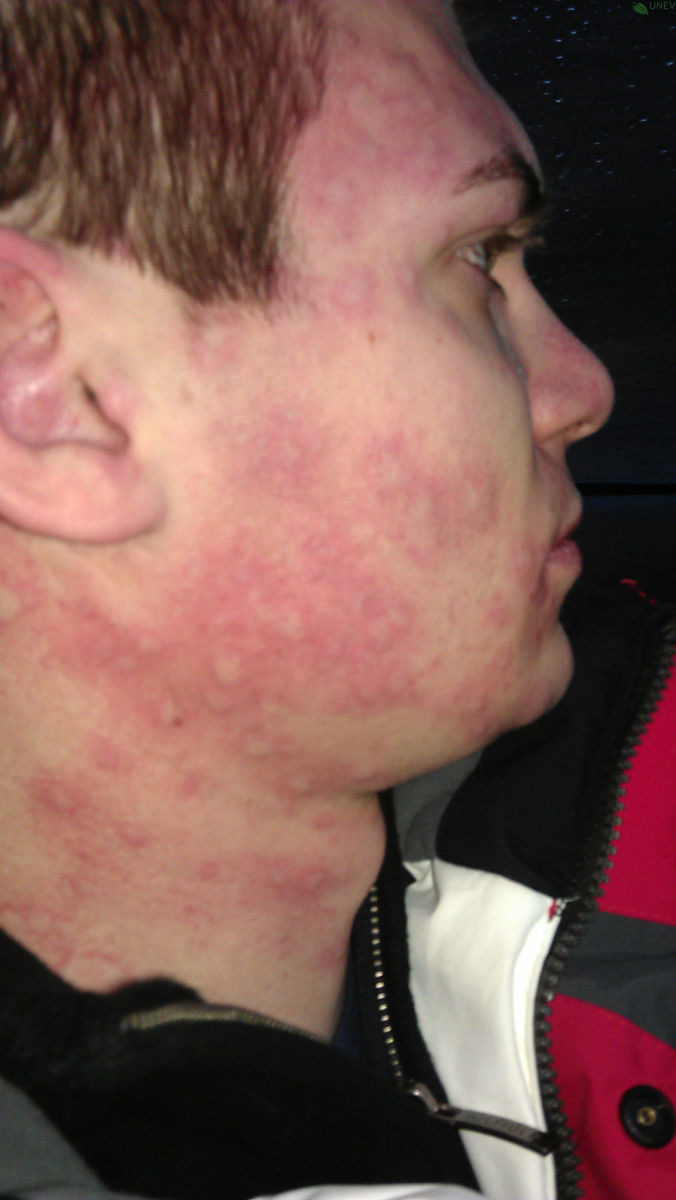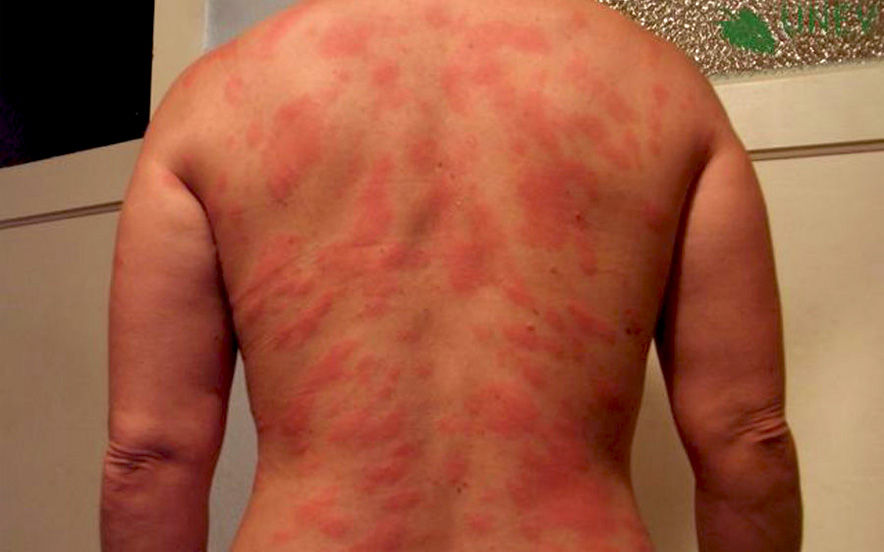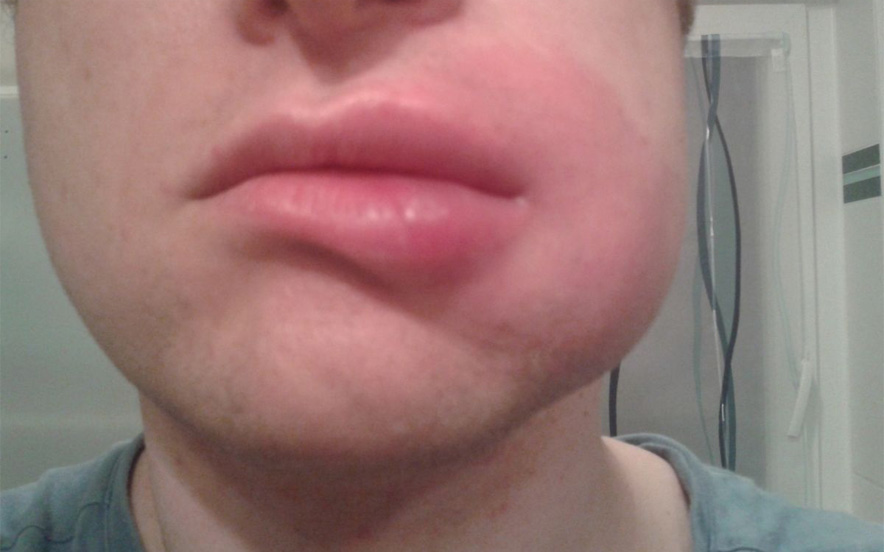Definition
Urticaria, is one of the most common diseases of the skin. The medical term for Urticaria is hives.



Photos of affected persons with typical symptoms such as wheals and angioedema
What are wheals?
Urticaria causes wheals to appear on the skin in certain areas or all over the body. These are small raised bumps on the skin that are usually reddish and itchy. It is called nettle rash as the skin has an appearance that is similar to that resulting from contact with stinging nettles. A typical feature of wheals is their fleeting nature, i.e. they are only on a part of the body for a few hours and leave no trace behind when they go away.
What are angioedema?
In addition to wheals, there may be swelling in the deeper layers of the skin. This is known as angioedema. This swelling often appears on the face, hands, feet or in the genital region. Some patients report painful burning with only a little itching in that area lasting one to two days. Some people with urticaria only have angioedema. In most cases, however, hives and angioedema are a recurring problem.
Duration and causes of the disease
Around one in four people develop urticaria in their lifetime. This often only lasts for a few days or weeks and does not cause any problems. This short-lived form of urticaria (< 6 weeks) is referred to as acute urticaria. Urticaria is much more difficult to bear when it lasts for several months, years or even decades. Urticaria that lasts for more than six weeks is referred to as “chronic urticaria”.
An important thing to bear in mind is that, as well as the acute and chronic forms, a distinction is also made between spontaneous urticaria and the inducible forms of urticaria. With inducible urticaria, symptoms only appear when a very specific trigger is present. In the case of cold urticaria, for example, it is the skin coming into contact with a cold stimulus. So symptoms only occur whenever the skin comes into contact with a cold stimulus. With spontaneous urticaria, there are no such definite triggers. Wheals and angioedema appear spontaneously in this case, out of the blue, seemingly when and where they want.
Urticaria is not an allergy!
Acute urticaria may in rare cases be due to an allergic reaction, but most often the reason for the occurrence of acute urticaria remains unclear (idiopathic). In some cases, acute urticaria can be caused by infections or taking certain medications.
For a long time, it was also assumed that chronic urticaria was an allergy. However, this is not the case, because neither the chronic spontaneous form nor the chronic inducible form are allergies. That may come as a surprise at first glance, because the symptoms of urticaria on the skin are very similar to those experienced by allergy patients. It is not uncommon for people to initially seek advice from allergists in both cases, and both conditions are often treated with the same drugs. This is because the symptoms of chronic urticaria, like the symptoms of allergic disorders, are triggered by allergy cells known as mast cells. Mast cells are activated in the case of both conditions and release histamine and other inflammatory substances.
In patients with allergy, this happens through contact with an allergen in the form of inhaling, eating or touching a substance from the environment to which they have developed an allergy.
In patients with chronic urticaria, this happens through autoantibodies, i.e. proteins produced by the body’s immune system that target the body’s own structures. This has important implications for diagnosis and the range of treatment options. Allergy tests are carried out on allergy patients to confirm the allergy. This is not helpful for patients with chronic urticaria. With allergies, “hyposensitisation”, i.e. the body getting used to the environmental substance to which someone is allergic, may be possible and can be useful. This is not the case with chronic urticaria.
Here is an overview of the similarities and differences between urticaria and allergy:
Urticaria= one of the most common skin diseases that causes wheals and / or angioedema (swelling) | AllergyThe immune system reacts to supposedly harmless allergens, i.e. foreign substances such as food or pollen |
UrticariaAutoantibodies, i.e. proteins produced by the body’s immune system, which activate the skin’s mast cells for no apparent reason or through physical stimuli such as pressure, friction, cold or sunlight or in rare cases an underlying allergy | AllergyAn allergen, i.e. a substance from the environment that comes into contact with the body through inhalation, eating or touching; depending on allergy type, these “triggers” activate different cells of the immune system (e. g. mast cells or T-cells) and trigger an allergic reaction |
UrticariaWheals, angioedema, redness of the skin, itching, in rare cases headaches, joint pain and abdominal pain, fatigue, diarrhoea, a feeling of tightness in the chest area | AllergyWheals, angioedema, redness of the skin, itching, cold-like symptoms, cough, sneezing, skin rash, watery eyes, itchy eyes, breathing difficulties, swelling of the mucous membranes, gastrointestinal problems |
UrticariaDermatologist, allergist | AllergyDermatologist, allergist |
UrticariaProvocation tests if necessary, avoid known triggers (only with inducible forms of urticaria), laboratory tests, taking antihistamines and / or omalizumab | AllergyAllergy tests, hypo- or desensitisation, taking antihistamines |
